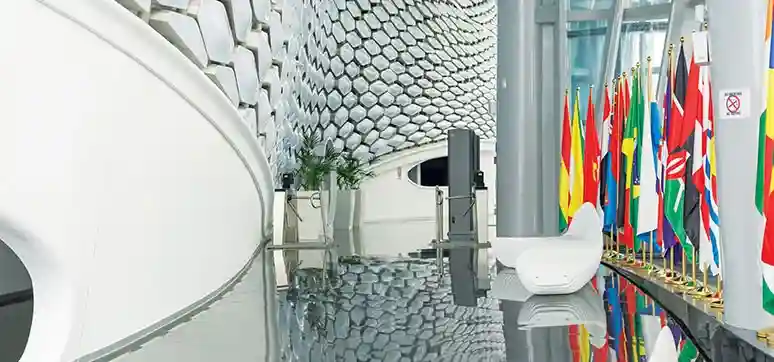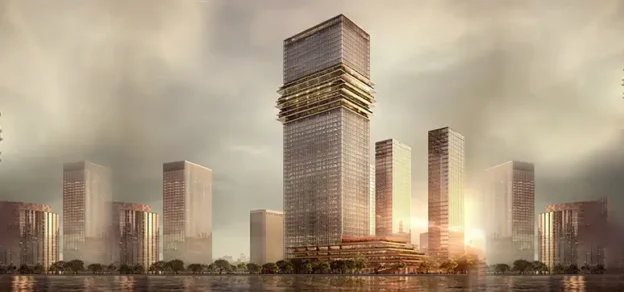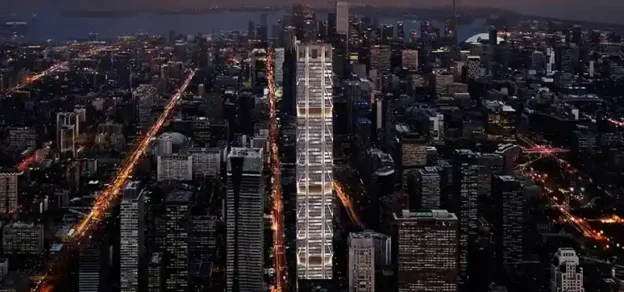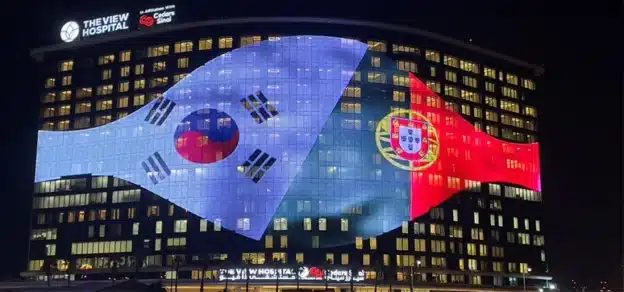The Energy Hall is placed towards the center of the 25 hectare expo site, just in front of the Kazakhstan pavilion or Science museum. The overall goal of the project was to create a cultural hub connecting the main central pavilion with two commercial buildings and the theater in between, all along the covered street. The venue was aimed to feel and be active regardless of its programming and daily “theatrical” activity. Ideally, the venue would be active any day of the week, any time, and expo or legacy mode.
The outer skin of the main hall was designed as an active programmable surface that would allow artists to enrich it with digital art. The potential of being programmable, or ideally also interactive was an important goal. We called this surface “digital active canvas”. The space between this “digital active canvas” and the outer glass layer becomes a very active public zone designed to be open for public independently of the use of the theater inside. The materiality, technology and expression of such “canvas” become the focus of an exciting design and fabrication process.
Several original concepts were developed and we decided to proceed with one where a “LED lit unit” would be the forming cell of the system. This “cell” is double sided, so it works on the outer “lobby” side and in the inner, smaller lobbies’ side. Each cell is framed with metal frames, connected to the main structural “tissue” that wraps around the main hall, following the shape of the main hall and its secondary circulations. The “digital art canvas” becomes a dynamic active system that “breath” with the space, enrich the interplay experiences and becomes the main expression of the Energy Hall theater all year round.
The second layer to enclose this lobby area is a clear glass wall that wraps around its skin. It is part exterior wall and part interior wall. It geometrically engages with the covered street roof framing the arrival from outside. The form guides visitors towards the main covered street entrance while providing great views of the interior space at the same time. The glass wall wraps the Digital Art Canvas, protecting it, revealing it, and making it visible 24-hours a day.
Envelope Details
The Energy Hall exterior enclosure used unitised thermally broken painted aluminum fixed window wall (storefront and curtain wall) with vision panels of high-performance triple glazing and solid frit insulated glass spandrel panels. The window wall oriented to the interior covered mall had vision panels of high-performance double glazing and solid frit insulated glass spandrel panels.
The roof was designed as an insulated low slope roofing system with building-integrated monocrystalline photovoltaic roof panels. The triple-glazed system value was .8 w/m2k with argon-filled glass having a U-value of .6 w/m2k. The solar heat gain coefficient was about .40 with a low 16% reflectance, consistent with the overall standards of the Expo project which encouraged heavily insulated glazing with relatively high solar heat gain coefficient in order to let in more light and heat, especially during winter.
Solid walls were designed as a heavily insulated .15 w/ m2K u-value. Being very open, public buildings, the Energy Hall and Retail pavilions had a 81% glazing ratio.
Fact File :
Client: It Engeneering
Architect: AS+GG
Structural Consultant: Werner Sobek
Façade Consultant: AS+GG
Commencement Date: December 2013 (design process)
Completion Date: April 2015 (Design process)
Area: 6,550 m2














